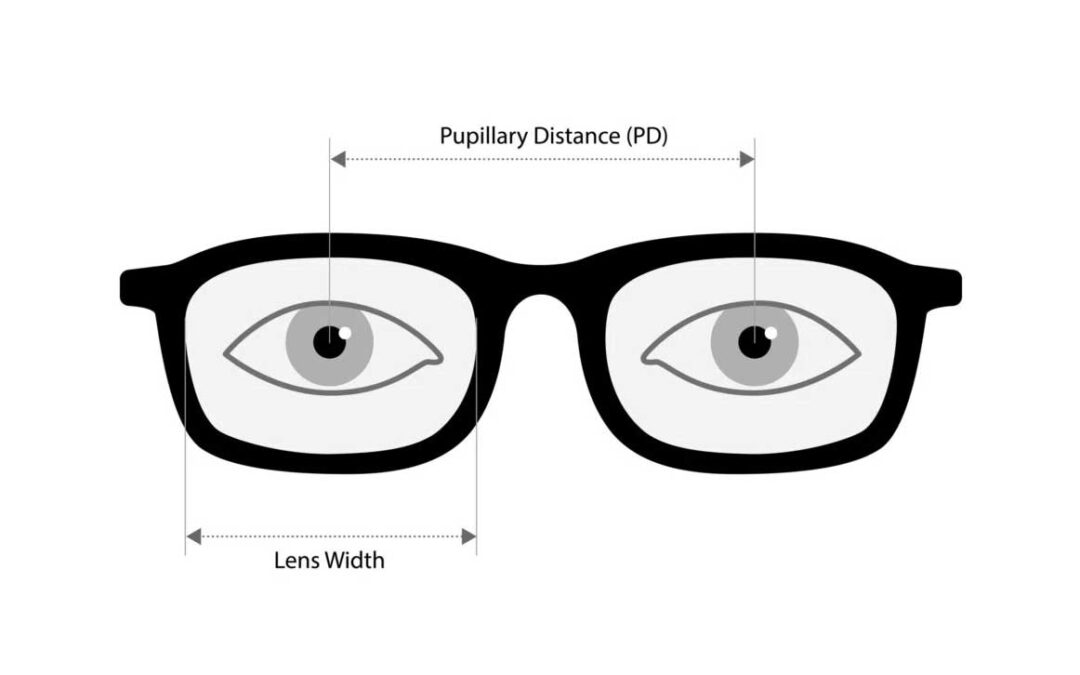What is PD (Pupillary Distance)?
Pupillary Distance (PD), is the measurement of distance between your pupils. PD plays a varying role in eyewear fitting depending on the type of lenses and the strength of your prescription.
This measurement can be important when selecting a pair of glasses because it ensures that the lenses are positioned correctly in front of your eyes.
How is PD used?
Simply put, when selecting glasses, PD, or Pupillary Distance, is used to make sure the position of the optical centers (the spot of a lens where you can see the clearest) is directly in front of your pupils.
The Impact of PD for Different Prescriptions
PD has a Minimal Impact for Low Prescriptions:
-
- For single vision lenses with low power (less than +/- 1.50 diopters), the PD is not a critical factor. In such cases, slight deviations in PD measurement have a negligible effect on the wearer’s vision or comfort.
PD is more Important with Higher Prescriptions
- As the lens power exceeds +/- 1.50 diopters, the accuracy of PD becomes important. Incorrect PD measurements in higher prescriptions can cause discomfort, eyestrain, headaches or even blurred vision, as the lenses may not align correctly with the wearer’s line of sight.
PD is Crucial for Progressive Lenses
- For those requiring progressive lenses, which cater to multiple vision fields, an accurate PD measurement is crucial. The precise alignment of these vision fields depends heavily on the correct PD, ensuring that each area of the lens is positioned in line with the corresponding viewing angle.
Does PD Change?
For most adults, once their PD is measured accurately, it does not change significantly over time. PD can change during childhood as part of the body’s natural growth process. But once an individual reaches adulthood, PD stabilizes and remains constant. Exceptions to this stability are rare and usually result from specific medical conditions or injuries that affect the eye structure.
How to Measure Your Own PD
Before you start measuring your PD, it’s important to know your prescription, if you have a prescription stronger than +/- 1.50, or plan to get Bifocal, Trifocal or Progressive Lenses, it’s recommended that you go and see an Optician. If you have an inaccurate PD your glasses can cause discomfort, eyestrain, headaches and more. You’ll probably have to order new lenses, which will take time and can end up being pricey.
What you’ll need
- A straight-edge ruler with millimeter measurements
- A mirror, mounted at eye level
- A pen or pencil and some paper
Step 1: Prepare Your Setup
Position yourself comfortably about 8 inches away from a mirror, ensuring the mirror’s surface is level with your eyes to maintain accuracy throughout the process.
Step 2: Align and Measure
- Place the ruler horizontally across your eyebrows or just below your eye line.
- Start by aligning the zero end of the ruler with the pupil center of one eye.
- Without shifting your head or the ruler, note the measurement on the ruler that aligns with the center of the other pupil.
Step 3: Record Your PD
The millimeter reading where the second pupil aligns on the ruler is your PD. Adult PD usually falls between 54 mm and 74 mm. Write down this number.
Step 4: Retake Your PD
Repeat the process several times. This is to help ensure you’re taking an accurate measurement. A few millimeters of variance can be expected, but larger discrepancies suggest the need for more careful measurement.
Additional Tips for Reliable Measurement:
- Conduct the measurement in a well-lit environment to ensure your pupils are clearly visible.
- Keep both eyes open during the measurement to prevent any skew caused by closing one eye.
- For those struggling with the method above, consider measuring each eye separately from the center of the nose bridge to the pupil center, and then add these measurements.
Do PD Measuring Apps Work?
Digital apps for measuring Pupillary Distance (PD) offer a convenient alternative to traditional methods. While some of these apps are fairly advanced and can provide reasonably accurate results, the accuracy and effectiveness can vary significantly from one app to another. Factors such as the quality of the smartphone camera, the lighting conditions, and the user’s ability to follow instructions correctly can all impact the precision of the measurement.
It’s important to note that while these apps are suitable for general use, they may not always deliver perfect accuracy. For individuals with prescriptions over +/- 1.50, even small inaccuracies in PD measurement can result in poor visual comfort or eye strain. Making it important to visit an optician for a professional measurement.
Conclusion
Accurate measurement of Pupillary Distance (PD) is essential for ensuring that eyeglasses fit correctly and provide optimal visual clarity. While minor inaccuracies in PD may be tolerable for low prescriptions, they can lead to significant issues such as discomfort, eyestrain, and blurred vision for those with higher prescriptions or progressive lenses. To avoid potential problems, it’s advisable to have PD measured professionally, especially when dealing with complex prescriptions. Understanding and correctly measuring PD is a critical step for anyone needing glasses to ensure they deliver maximum effectiveness and comfort.

